Imbolc Traditions & Rituals – Celebrate Renewal & Light
Table of Contents
Last Updated on January 27, 2025 by Abigail Adams
Introduction to Imbolc
Imbolc is the third of the Sabbats celebrated in the Wheel of the Year. Falling on February 1st or 2nd, this sacred day marks the midway point between Yule (the Winter Solstice) and Ostara (the Spring Equinox). It arrives during the harsh, cold grip of February – a time historically known as the Wolf Month in ancient Scotland. The month was also referred to as the Dead Month, emphasizing the challenges of winter’s peak.
Yet, as bleak as the season may seem, Imbolc heralds the subtle but undeniable signs of life’s return. New lambs are born, soft rains nourish emerging grass, and birds like ravens begin building their nests. Even the larks are said to sing with a clearer voice, all signaling the slow but sure arrival of spring.
Historical Significance of Imbolc
The name “Imbolc” is rooted in Irish Gaelic, with linguistic ties to renewal and fertility. “Oimelc” translates to “ewe’s milk,” reflecting the traditional timing of lambing season. Imbolc itself means “in the belly,” symbolizing the unseen life stirring within the Earth Mother. This day celebrates both the promise of spring and the growing strength of the sun.
Imbolc also marks the transition from the Crone’s time to the youthful Maiden in the cyclic narrative of the Goddess. It is a moment of shifting energy, acknowledging the turning of the Great Wheel of the Year from darkness toward light.
Brigid and the Fire Festival
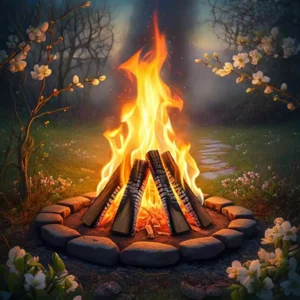
Imbolc is one of the Celtic Fire Festivals, and its connections to fire and light make it a particularly evocative celebration. At its heart is the goddess Brigid (also spelled Brighid, Brìde, Brigit, or Brìd), revered in Celtic tradition. She is the goddess of poetry, healing, and smithcraft, as well as a protector of sacred wells, holy flames, and transformation.
The lighting of fires and candles during Imbolc symbolizes renewal, warmth, and the growing power of the sun. Later, as Christianity spread, Brigid became associated with Saint Brigid. Although churches were dedicated to her, Saint Brigid’s feast day was eventually removed from the Roman Catholic calendar in the 1960s.
Cultural Celebrations of Imbolc
Imbolc’s themes of purification, renewal, and light appear in many cultures throughout history. For example, in Ancient Israel and Judah, February 2nd marked the Festival of Trees in honor of the goddess Ashram. Similarly, the Romans celebrated Lupercalia, a festival that honored the legendary origins of Rome through the story of Romulus and Remus.
Ancient Egyptians observed the Feast of Nut, connecting the goddess Nut with this transitional time. Meanwhile, Christians and Catholics adopted aspects of these older traditions into Candlemas, celebrated as the Feast of the Purification of the Virgin Mary 40 days after Christ’s birth. Religious law at the time dictated that a woman was ritually purified 40 days postpartum.
Indigenous cultures in North America also celebrated this time of year. Among the First Nations, midwinter festivities often welcomed the promise of spring. For instance, the Navajo honored the goddess Changing Woman with their Sing Festival. The Iroquois Nation held ceremonies focused on dreams and renewal during their Midwinter Ceremony. The Dream Ceremony stood out, where individuals shared their dreams with elders to gain insight or acted them out in guessing games. Dreams were viewed as a vital connection to one’s soul, and losing one’s dreams equated to losing a part of oneself.
From Serpents to Groundhogs
European traditions surrounding Imbolc also made their way to America, transforming into customs like Groundhog Day. Non-Gaelic Celtic lore tells of a serpent emerging from its hole, regardless of heavy snow, to mark the day of Brigid. This evolved into the modern belief that if a groundhog sees its shadow on February 2nd, winter will persist for another six weeks.
These traditions, while distinct, all tie back to the hope and anticipation of spring’s arrival. Imbolc reflects a universal human desire to see the cold and darkness give way to warmth and light.
Symbolism and Traditions of Imbolc
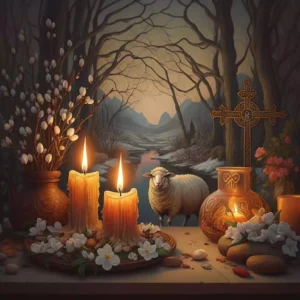
Imbolc reverberates with profound symbolism. It is a celebration of new beginnings, fresh opportunities, and rebirth. Lighting candles honors the sun’s growing strength, while spring cleaning symbolizes the act of clearing away stagnant energy to make room for new life.
Crafting Brigid’s Cross from rushes or straw is a traditional way to pay tribute to Brigid and to invite her blessings for protection and abundance. Offering blessings to seeds for planting connects individuals with the cycles of nature, aligning their intentions with the season’s energy of growth.
At its core, Imbolc reminds us to plant the metaphorical seeds of our dreams, nurturing the hopes and desires we wish to see fulfilled in the coming year.
A Time to Renew and Rejuvenate
Throughout history, Imbolc has been a beacon of hope during the cold, dark days of late winter. It invites us to pause, reflect, and align ourselves with the natural cycles of the earth. This sacred time encourages us to breathe new life into dreams we may have thought lost and to look forward to the promise of spring.
Imbolc is more than just a date on the calendar; it is a celebration of the endless cycle of renewal and the quiet magic of life unfolding, even beneath winter’s cover. By honoring these traditions, we draw closer to the rhythms of nature and the timeless wisdom of those who came before us.
Our Imbolc Blessing Spell
Imbolc Blessing Spell
-
Seasonal Spells, Spiritual Cleansing Spells
Imbolc Blessing Spell – Rekindle Your Inner Light
Original price was: $89.00.$29.00Current price is: $29.00.Step into the season of light and renewal with our Imbolc Blessing Spell, a sacred ritual honoring the energy of Imbolc and the divine power of Brigid. Designed to awaken…
A Different Viewpoint on Imbolc and Its History
Introduction to Brigid
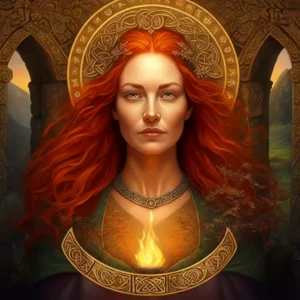
“Come with me,” said Brigid, “I am going to put my mantle around the Earth because it has dreamed of beauty.”
This season belongs to Brigid, the revered Celtic goddess who later became a celebrated Christian saint. She is the goddess of poetry, healing, and smithcraft, radiating wisdom and inspiration. Her festival, originally held on February 1 and rooted in Pagan traditions, was known as Imbolc or Oimelc. These names reference the lactation of ewes, symbolizing the life-giving flow of milk and the promise of spring. Brigid’s presence illuminates both Pagan and Christian observances, emphasizing grounding themes of life, renewal, and light.
Imbolc and Candlemas
Over time, Imbolc transitioned into Candlemas Day, observed by the Catholic Church on February 2. This festival honors the Virgin Mary and features the ceremonial lighting of candles, mirroring the light-bringing essence of Brigid. Such adaptations show how deeply woven Pagan beliefs were into early Christianity.
Imbolc’s themes of foretelling and omens also evolved into more modern customs, such as Groundhog Day, where a groundhog’s shadow predicts the remaining weeks of winter. These customs serve as reminders of how Imbolc’s promise of spring lives on, even in today’s secular traditions.
Signs of Spring
February is often regarded as a harsh and bitter month. To the Scots of old, it fell within the Wolf Month (Faoilleach) or Dead Month (a’ marbh mìos), reflecting its cold and lifeless nature. Yet, amidst this desolation, the earliest signs of spring emerge.
Lambing season begins, with ewes producing milk to nourish their young, an enduring symbol of renewal. The soft rains bring forth new grass, ravens build their nests in anticipation of the season ahead, and larks sing with a clearer voice. These small but steadfast symbols of hope remind us that life persists, even in adversity.
Cultural Traditions
Across the Celtic lands, the vibrancy of Brigid’s season takes on unique forms.
Ireland
Fields are tilled in preparation for seed planting, calves are born, and fishermen eagerly await calmer seas to resume their work. The promise of spring resonates in both the earth and the lives of the people preparing for abundance.
Scotland
The Cailleach, the Old Woman of Winter, begins her transformation into Bride, the Young Maiden of Spring. According to some tales, Bride’s release from the Cailleach’s grasp awakens the spring and rekindles the sun’s fire. Slowly, the world shifts from scarcity to abundance as winter loosens its hold.
Brigid’s Deeper Legacy
Cormac’s Glossary describes Brigid as “The Exalted One… woman of wisdom… a goddess whom poets adored.” While she is often portrayed as a wide-eyed maiden encircled by children, her power runs far deeper. She is an ancestral deity, a mother goddess venerated by many European tribes.
Brigid’s triple nature is reflected in her aspects as a poet, healer, and smith. Some legends describe her as three sisters, Brigid the Physician, Brigid the Smith, and Brigid the Poet, but this is likely an embodiment of her multifaceted roles. She is also tied to the practical crafts that sustained early Celtic society—dying, weaving, brewing, and agriculture.
She embodies abundance and regeneration, deeply connected to livestock and natural cycles. Irish rivers like the Brigidine reflect her enduring legacy and, in some traditions, she is even credited with inventing beer!
Rituals and Celebrations for Imbolc
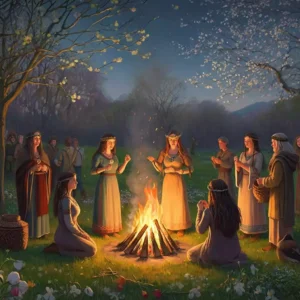
Imbolc is the perfect time to honor both light and inspiration, drawing strength from Brigid and the growing sun. Here are a few ways to celebrate and connect with the sacred energy of this season:
Sun and Brigid Celebrations
Pay homage to Brigid through poetry, song, and the lighting of candles. Acknowledge her guidance as the bringer of wisdom, renewal, and abundance.
Initiation and Dedication Rituals
This is an ideal time for initiations or dedications to the Goddess, aligning your own energy with that of the season.
Divination
Use tools like tarot, runes, or meditate in trance for insight. With Imbolc’s power, you can draw inspiration for future growth or reflect on lessons from the past to plan your path forward.
Celebrating Earth’s Awakening
Imbolc reminds us that the Earth will soon awaken from her winter slumber. Honor this time by planting the seeds of your intentions and nurturing your hopes for the year.
Reflection
Imbolc calls us to reconnect with hope and renewal. It promises that brighter days are ahead as the Earth stirs from her winter sleep. No matter how cold or harsh February feels, the warmth and light of spring are on their way.
Brigid’s ancient wisdom guides us to celebrate growth, creativity, and abundance. She invites us to weave our dreams and intentions into the fabric of the year ahead, trusting that, like the lambs and the soft rains, new life will emerge when the time is right.
This season is not only a celebration of spring’s visible return but also a reminder of the unseen strength and beauty stirring within us all.
Saint of the Flame – We Are All Her Daughters
Introduction to the Flame
“…she shall arise like a shining sun…” — Lives of Saints, The Book of Lismore
The sacred flame of Brigid is more than just a physical fire. It is a symbol of her enduring presence, creativity, and divine inspiration. Historically, this flame was lit as a devotion to Brigid, the goddess and later the saint, embodying her triple aspects of poet, healer, and smith.
The tradition of tending the flame is steeped in reverence and dedication. Women throughout history have faithfully kept her fire alive, each tending it in her own way, connected as part of a larger spiritual community. Together, they honored the divine, their lineage, and their own personal connection to Brigid.
The Daughters of the Flame
On a sacred twenty-day rotation, women in earlier times tended Brigid’s flame. Each woman would have her turn, a solitary yet profoundly connected ritual, culminating on the twentieth day when it was said that the Goddess Herself kept the flame alive. These women, bound by duty and devotion, became known as “The Daughters of the Flame.”
This fire was housed in a protected space, typically surrounded by hedges which served as a barrier. Men were not allowed to enter this sacred enclosure, preserving its purity and sanctity. Even the women who tended the fire observed strict rituals, never blowing on the flame with their mouths, but instead using bellows or fans to sustain it.
The sacred flame was more than a physical phenomenon; it epitomized devotion, a living manifestation of Brigid’s vibrant energy.
Modern Practices
Today, the flame of Brigid is no longer confined to a singular sacred site, grove, or monastery. Instead, it is rekindled in homes, on personal altars, and in spaces that hold meaning for her followers. From desks to picnic tables, her flame burns in hearts and homes across the globe.
This shift reflects the enduring adaptability of Brigid’s worship. While the communal element remains, the dispersal of her flame speaks to the individuality of modern devotion. It’s a deeply personal act, yet it connects her followers in ways that transcend geography and time.
The reasons for lighting her flame today are as varied as her devotees. Some do so to honor her aspects as poet, healer, and smith. Others use the flame as a reminder of inspiration, strength, and the power of renewal. Each flame represents a commitment—not just to Brigid, but to the fire within ourselves.
Lighting the Sacred Flame
Tonight, as we light our candles in Brigid’s honor, we emulate the perpetual flame that once burned in Kildare, her sacred home. With each candle lit, we take up the responsibility of tending the sacred flame—not just Brigid’s, but our own.
The initial lighting of the flame often follows age-old traditions. Typically performed by a virgin or maiden, this act signifies purity, potential, and the fresh energy of new beginnings. Yet, whether lit by a maiden or someone of any walk of life, the act itself is deeply symbolic. It is a declaration of reverence for Brigid’s power, an acknowledgment of her light that inspires us all.
The flame is a reminder that, just as Brigid tended to the needs of others, we too must nurture and tend our own inner light. It is in this act of devotion, reflection, and care that we truly embody what it means to be her daughters.
Reflection
The tradition of Brigid’s flame has always been one of shared responsibility and sacred connection. Whether it burned in a sheltered grove, a monastery, or now on a kitchen counter, its essence remains the same. The flame is more than just fire—it is creativity, healing, and transformation.
By lighting her flame, you join a lineage that stretches across centuries. You honor not just the Goddess and the saint, but also yourself and the fire you carry within. Brigid’s light lives on, shining brightly in all who honor her, inspiring us to rise like the shining sun.
How to Perform a Imbolc Ritual
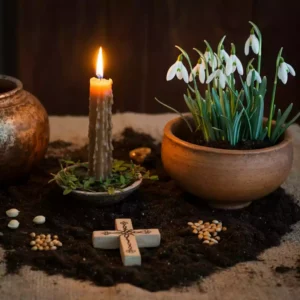
Introduction to the Imbolc Ritual
Imbolc is a sacred time to honor renewal, hope, and the stirrings of new beginnings. Whether you celebrate with a group or alone, this ritual serves as a reflection of your inner growth and the light awakening within. For those practicing solo, this ritual provides an opportunity to connect deeply with yourself, the Goddess, and the Earth. Prepare your space, gather your tools, and step into this moment of transformation.
Lighting Your Personal Flame
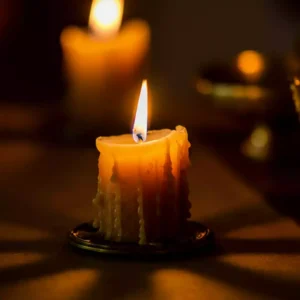
Begin by lighting a central candle. This flame represents your connection to Brigid and the light within you. Sit quietly before the flame, allowing its warmth and glow to ground you in the moment.
Hold your candle in your hands and whisper a prayer or intention. When ready, light your candle from the central flame. Take a moment to feel the power of this act. You are tending your own flame—a solitary yet profound connection to the Goddess and the light of the season.
Guided Meditation
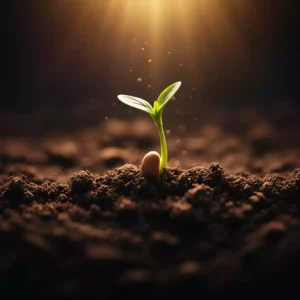
Once your candle is glowing, settle into a comfortable seat. Close your eyes, breathe deeply, and relax into the stillness around you. With each breath, release tension and allow yourself to melt into the sacred energy of the moment.
Picture your skin holding you softly and securely. Feel the gentle pressure of the Earth below you and the warmth of the room around you. Imagine yourself becoming a seed, light as air, carried by the soft caress of a breeze. You land in rich, dark soil, where you burrow deep into the Earth Mother’s womb to rest.
Feel the Mother cradling you, her presence nurturing your potential. Through the winter months, you sleep, hidden from the light. Yet deep inside you, something stirs—a spark of life waiting, growing. Slowly, the soil around you begins to tremble, and you sense the first hints of spring approaching.
Embracing Personal Growth
Feel the push within you as the energy of spring awakens. Your outer shell feels tight, and you know it is time to shed the old and step into the new. But fear whispers to you—“What if I fail? What if I’m not enough?”
Take a moment to name your fear. Look at it clearly and compassionately. Feel its weight and acknowledge its presence. Then, gently set it aside. Today, you will not be defined by fear but by the strength and courage within you.
Focus on the dream that lies ahead. What do you wish to grow? See it in your mind’s eye—a vibrant possibility full of hope and potential. Allow this vision to fuel you, filling you with warmth and light.
Now, feel yourself breaking free. You shed your old skin, leaving behind everything that no longer serves you. With strength and determination, you move upward through the soil, bursting into the light. The sun kisses your tender shoots, and the Earth Mother nourishes your roots. You have become something new, ready to grow and flourish.
Returning to the Present
Hold this vision of growth and renewal within your heart. Think about the intentions you wish to nurture in the coming months. What seeds are you planting? How will you care for them? Whisper them aloud or write them in a journal to solidify your commitment.
Take a moment to cleanse yourself with a symbolic act. Sprinkle yourself with saltwater, wash your hands, or simply envision the soil and remnants of the past falling away. This is your moment of rebirth, your declaration of transformation.
When you feel ready, take a deep breath and begin to return to the present. Gently open your eyes, stretching your arms and legs to ground yourself. Extinguish your candle with gratitude, holding its light within as you step forward into the new season.
Ending Reflection
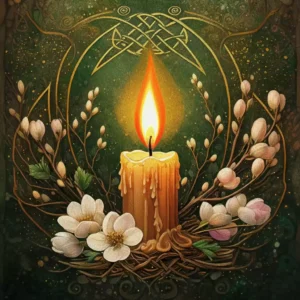
Celebrating Imbolc solo is a powerful way to honor the cycles of nature mirrored in your own life. It invites you to recognize the courage required for growth and the infinite possibilities that lie ahead.
By lighting your flame and planting the seeds of your dreams, you honor not only the Goddess but your own unique potential. May this ritual guide you as you walk boldly into the light of new beginnings. Blessed be, and may your dreams take root and grow strong.
Completing the Imbolc ritual allows you to step into the essence of the season—a time of renewal, courage, and the nurturing of dreams. With each flicker of your personal flame, you honor the cycles of nature and the divine energy within yourself. Carry the light of Imbolc into your daily life, letting it guide your steps as you tend to the seeds of change and possibility. Trust in your transformation, and remember that even the smallest spark can grow into something magnificent. May the wisdom of the Goddess and the promise of spring inspire you to keep moving forward, one brave step at a time. Blessed be.


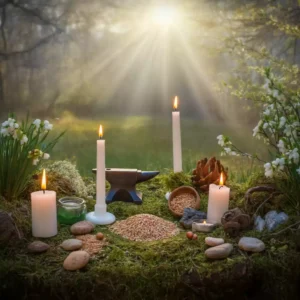
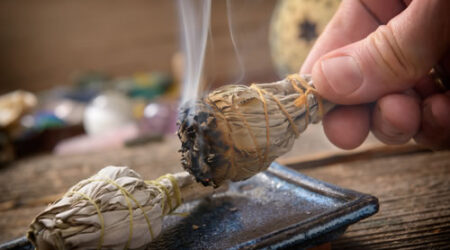
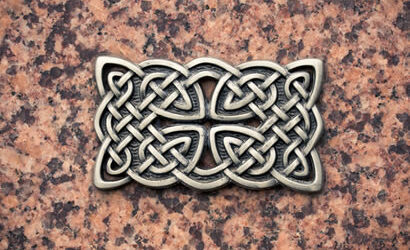
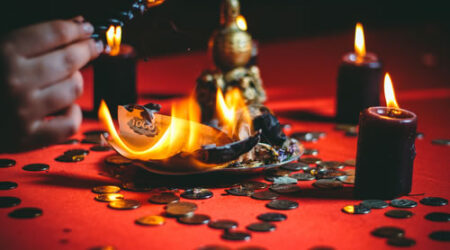
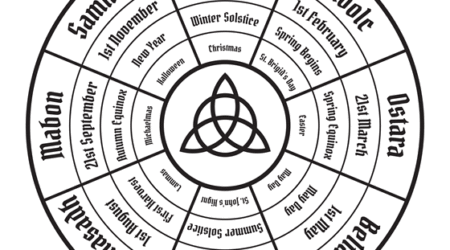


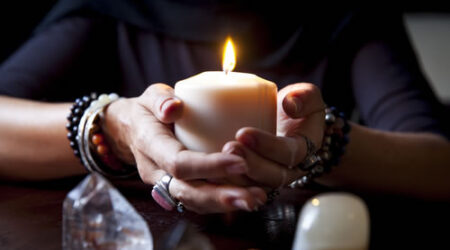

Leave a Reply